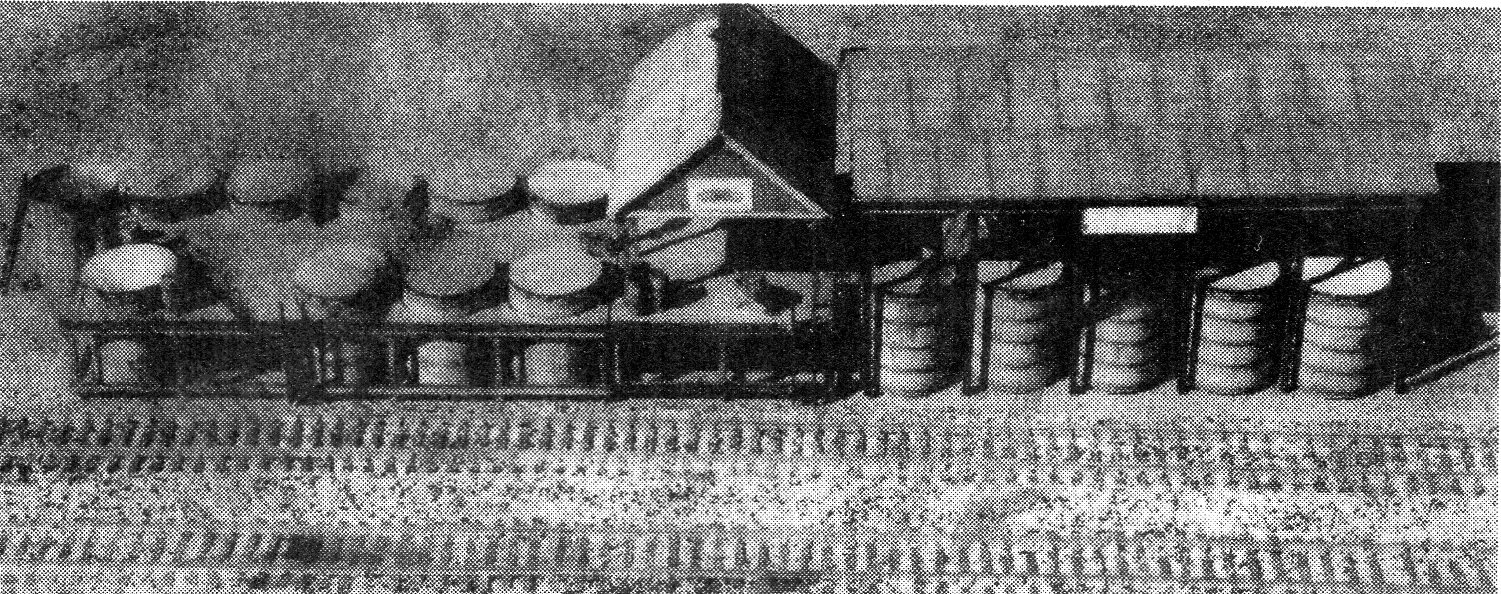
Submitted by Nute Chapman
From Onaway Outlook November 2, 2012

 |
Submitted by Nute Chapman From Onaway Outlook November 2, 2012 |
 |
Caption: THIS WEEK'S picture is of an original pickle station.
 Onaway had its own Pickle Works or pickle station as they are sometimes called. My father often mentioned the Pickle Works
when we would go by Shoemaker's Store. We also had family who lived on Seventh Street and on Spruce Street who worked in the
big saw mill where Spruce Street and Sixth Street meet, next to the Pickle Station. We knew that the Pickle Station
was already up and running in 1923. It was in Block 8, which was about two acres in size. The land and station were owned
by Libby, McNeil and Libby of Alma.
Onaway had its own Pickle Works or pickle station as they are sometimes called. My father often mentioned the Pickle Works
when we would go by Shoemaker's Store. We also had family who lived on Seventh Street and on Spruce Street who worked in the
big saw mill where Spruce Street and Sixth Street meet, next to the Pickle Station. We knew that the Pickle Station
was already up and running in 1923. It was in Block 8, which was about two acres in size. The land and station were owned
by Libby, McNeil and Libby of Alma.
We have a copy of the rental agreement between Lee McCreery and the Libby people that was signed on the 12th of June, 1923.
The land, buildings and tanks were rented by Lee for five years for a sum of $25 a year, payment in advance each year. We
don't know how long Lee operated the Pickle Works, but do know that it was still in operation in the 1930s.
Brine vats were made of many different woods. Today, at auction they bring unbelievably high prices. They are being
used for hardwood floors, dining room tables, pool tables and furniture.
Pickle stations were operated across the U.S. from the late 1800s into the 1960s. The stations were always built next to
railroads. Onaway's Pickle Works was build on the spur that came into the M.C. Cate Mill.
The owner would furnish the seed and buy the cucumbers from the local farmers and sort and salt them in the big brine vats,
to be shipped out by rail later. Choice size pickles were sorted out and put into a vat of brine with salt, spices, dill weed and
vinegar in dill pickle casks. These pickles were the choice of the crop. Other pickles were simply stored in salt brine.
Once ready, the pickles were loaded into railcars to be shipped to a finish plant. A platform was build around the vats
that allowed the workers to dip the pickles out of the vats with nets and fill wheelbarrows that would be wheeled up a plank
and dumped into the tank cars. Next, the brine would be pumped by hand into the tank cars.
In talking to Marie (Rogers) LaLonde, we find that she remembers going with her dad (Don Rogers) to Metz and hauling
cucumbers back to the station in Onaway. Marie tells us that Metz also had a pickle station. Marie can remember her dad
driving to the backside of the gas station at Shoemaker's. The building had a large sliding door where you backed the
truck into to unload the cucumbers. She also remembers that Helen Getzmeyer was the secretary who checked your load in.
The cucumbers were sorted and boxed according to their size.
Ruth (Rogers) Szymoniak remembers her dad (Ralph Rogers) having a large cucumber patch on their farm. Ralph was fussy
about how the cucumbers were picked. The small ones were treated with care as they had more value when delivered to the pickle
station. When talking to Ruth, I kind of got the message that picking cucumbers was not one of her favorite chores. Ray
Szymoniak remembers seed being given out to the local farmers, but his dad did not grow any.
When our children were growing up at home we always had a 10-gallon crock of dill pickles and a 10-gallon crock of sauerkraut
stored in the back shed. we could remove the cover from these crocks and get a pickle out of the half-frozen brine or use a
large fork and dig out enough frozen kraut for supper.
Today we have 20-plus quarts of dill pickles stored in a spare refrigerator in our back shed, it works.
Some of you readers should remember Baldy McQuaid's beautiful flower garden between the Outlook building and the Clark
Hotel. It was a section cut from one of the pickle vats.
Today pickles are hauled to the pickle plants in large dump trucks, like the ones used to haul sugar beets. The plants
still use large brine tanks to make the pickles we eat today.
-Onaway Outlook, November 2, 2012, p.10.
Retyped by J. Anderson.